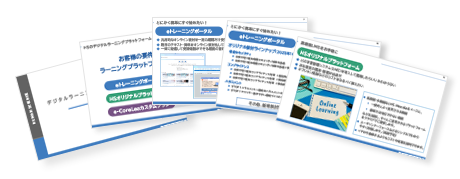2017.10.11
Basic e-Learning for Corporate Education (Theory)
Fundamental Theory: Instructional Design (ID)

The foundation of ID was created in the United States during World War II.
Even though it was over 70 years ago, it continues to incorporate new theories, evolve, and maintain its position as a fundamental theory. Even at the world's largest talent development event, ATD ICE, approximately 10% of sessions still focus on ID as the main theme, and many other sessions are also based on it.
The "ADDIE model", which is one of the main theories that make up the ID, defines the process of "analysis → design → development → implementation → evaluation" for instructional materials. It is a concept similar to the PDCA cycle in business, and not only does it require prior analysis, but it also defines the need for continuous evaluation and review.
・"Analysis": Who should learn what
・"Design": What should be achieved (goals), and how to achieve it
・"Development": Production of education based on analysis and design
・"Implementation": Implementation of education
・"Evaluation": Confirmation of whether education has contributed to the goal
(Note) Goal: What learners should achieve through education, Purpose: The reason for implementing education and what the organization wants to achieve
However, due to issues such as inadequate education systems and costs (ROI) within companies, the reality is that the appropriate phases of "analysis," "design," and "evaluation" are still not being implemented.
In addition, ID is formed by combining various theories such as the ARCS model for enhancing learning motivation and Ganje's 9 professorial phenomena.
From a perspective of psychology, Learning Designer (LD) analyzes how people learn and designs optimal learning using techniques such as creating and delivering educational materials. LD is a concept that those who provide education, like us, should learn first.
Recently, neuroscience and other new perspectives have been used to explore actual brain reactions and research effective educational systems.
In particular, in the field of e-learning, microlearning (a system that delivers necessary learning at the necessary timing), adaptive learning (learning personalized for individuals), and social learning (support for learning in informal environments) are all part of a movement to fundamentally change the way education and educational materials are approached.
These theories, concepts, and techniques also inherit the ideas of LD at their core.
Purpose of Implementation of Education
In e-learning, the ultimate implementation goal (educational purpose) can be said to be the achievement of the company's business goals. In addition to achieving sales targets, education/e-learning is one of the means to reach various goals, including sustainability, CSR/CSV, prevention of losses due to security incidents, and improvement of technical capabilities.
Therefore, the purpose of the educational material should not end with filling in knowledge.
The purpose of implementing education is to actually utilize that knowledge and change behavior (behavioral change).
Even in ID, it is recommended to set goals for learners to "be able to do" rather than "understand".
Learning Culture
Do you remember the content of the classes you were not motivated to take during your student days?
Corporate education in Japan is dominated by "forced education" (do it because you are told to / you have to). In the case of group training, there may be opportunities for the instructor to passionately explain "this is the education you need" by reading the atmosphere, but this is not possible with e-learning, which does not allow for real-time communication.
However, there may be employees who are still motivated and desperately trying to learn, but it must be said that these employees are in the minority. I feel that the significance of e-learning in Japan is very precarious. In other countries, there has been a desperate effort to think about how to motivate and encourage action, such as gamification and microlearning. However, Japan has not evolved from its traditional, top-down education for over ten years.
"It is necessary to review and incorporate the efforts of "bringing out motivation", "turning knowledge into action", and "changing the company" into education. If we do not nurture the people who make up the company, the company itself will not grow. We believe that it is the responsibility of the company to create a "learning culture" through habitual learning, rather than just ending education with new employee training. ID is the foundation for realizing this."
※We also plan to introduce various themes (such as systems, technology, and the latest trends) in the future.

Author:
Keigo Ryuno
Education Solutions Department, Consulting Unit
・Experience as a training instructor and web designer
・Engaged in education design and e-learning development
・Learning Designer (eLC certified)
・ATD International Professional Member
Contact Us:
Phone Number: 03-5321-3111
hsweb_inquiry@science.co.jp
Icons made by Vectors Market from www.flaticon.com is licensed by CC 3.0 BY
Illustrated by http://all-free-download.com/
Latest Blog
- 2024.04.02
- English Learning Using Moodle and ChatGPT












